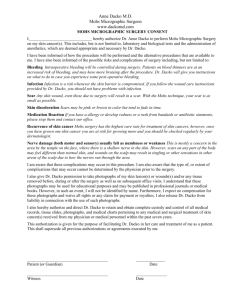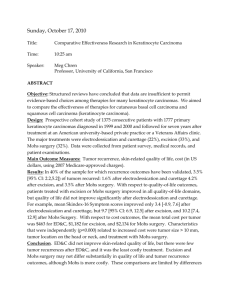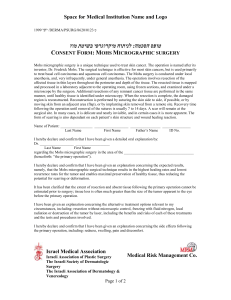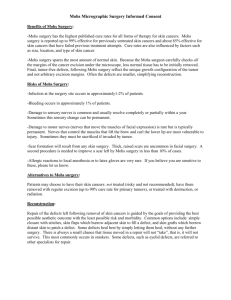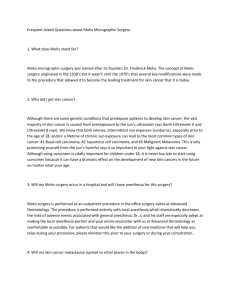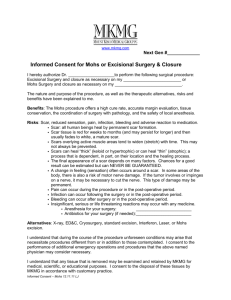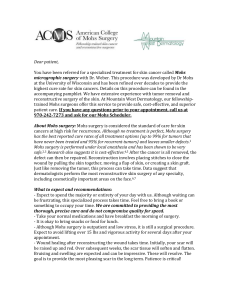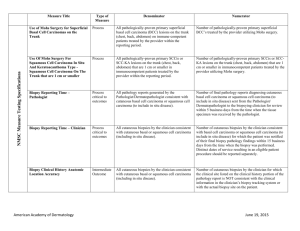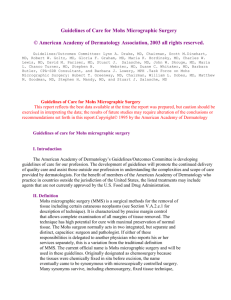Mohs LCD 122014
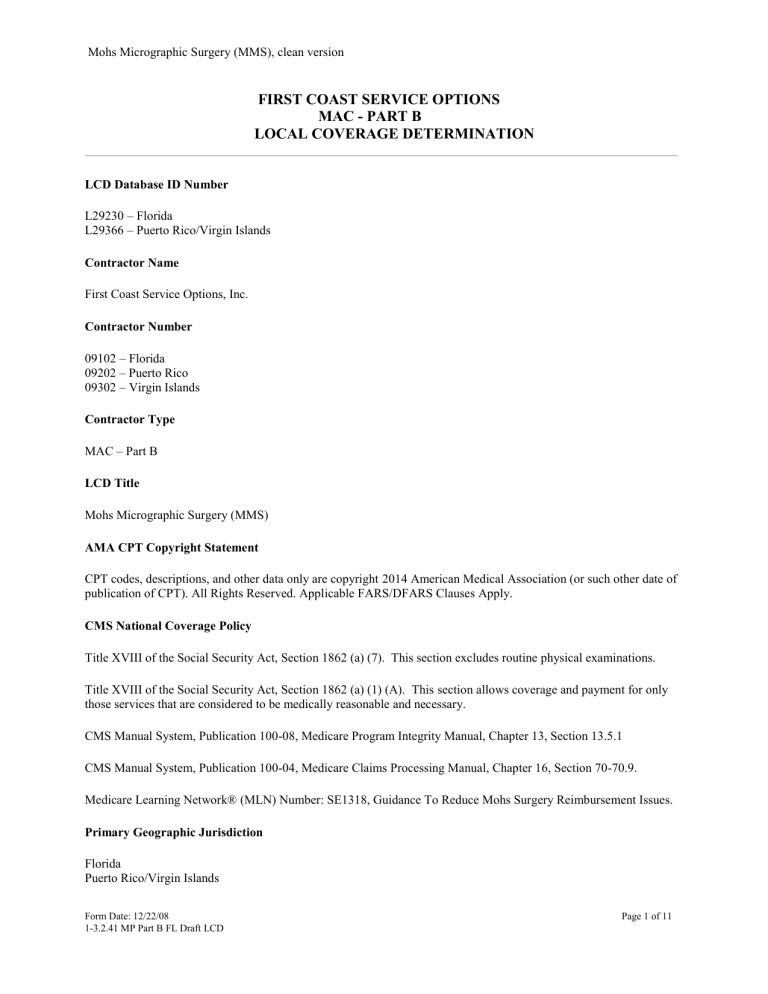
Mohs Micrographic Surgery (MMS), clean version
FIRST COAST SERVICE OPTIONS
MAC - PART B
LOCAL COVERAGE DETERMINATION
LCD Database ID Number
L29230 – Florida
L29366 – Puerto Rico/Virgin Islands
Contractor Name
First Coast Service Options, Inc.
Contractor Number
09102 – Florida
09202 – Puerto Rico
09302 – Virgin Islands
Contractor Type
MAC – Part B
LCD Title
Mohs Micrographic Surgery (MMS)
AMA CPT Copyright Statement
CPT codes, descriptions, and other data only are copyright 2014 American Medical Association (or such other date of publication of CPT). All Rights Reserved. Applicable FARS/DFARS Clauses Apply.
CMS National Coverage Policy
Title XVIII of the Social Security Act, Section 1862 (a) (7). This section excludes routine physical examinations.
Title XVIII of the Social Security Act, Section 1862 (a) (1) (A). This section allows coverage and payment for only those services that are considered to be medically reasonable and necessary.
CMS Manual System, Publication 100-08, Medicare Program Integrity Manual, Chapter 13, Section 13.5.1
CMS Manual System, Publication 100-04, Medicare Claims Processing Manual, Chapter 16, Section 70-70.9.
Medicare Learning Network® (MLN) Number: SE1318, Guidance To Reduce Mohs Surgery Reimbursement Issues.
Primary Geographic Jurisdiction
Florida
Puerto Rico/Virgin Islands
Form Date: 12/22/08
1-3.2.41 MP Part B FL Draft LCD
Page 1 of 11
Mohs Micrographic Surgery (MMS), clean version
Oversight Region
Region I
Original Determination Effective Date
02/02/2009 – Florida
03/02/2009 – Puerto Rico/Virgin Islands
Original Determination Ending Date
N/A/
Revision Effective Date
MM/DD/YYYY
Revision Ending Date
MM/DD/YYYY
Indications and Limitations of Coverage and/or Medical Necessity
Mohs micrographic surgery (MMS) is a microscope-guided tissue-sparing surgical procedure used for the removal of certain complex or ill-defined cutaneous neoplasms of the skin and histologic examination of 100% of the surgical margins. MMS uses precise measurements of tumor margins to remove cancerous cells and leave healthy tissue intact. The procedure is performed in successive stages to remove extensive tumors, as needed. The surgery requires the integration of an individual functioning in two separate and distinct capacities: surgeon and pathologist. If either of these responsibilities is delegated to another physician or other qualified health care professional who reports the service(s) separately, the MMS codes should not be reported.
The majority of skin cancers can be managed by excision or destruction techniques. MMS is usually an office procedure done under local anesthesia and/or sedation.
To support medical review (post procedure prepayment or post payment audit) of documentation, this LCD addresses the reasonable and necessary threshold for coverage based on three requirements—
1) Qualifications of the physician and office/facility team (See Limitations section.) ;
2) Characteristics of the lesion pre-procedure (See Indications section.) ;
3) Documentation of the medical need for the Mohs micrographic technique and associated plans for the repair.
Procedures that exceed the medical need are not reasonable and necessary (not a Medicare covered service), therefore, documentation (pre-procedure E/M note and/or post-procedure operative notes) must address (a) why the lesion will not be (was not) managed by standard excision or destruction technique and (b) why procedures
(when utilized or referred to a plastic surgeon) for complex repair, adjacent tissue transfer or rearrangement, flap, or graft codes are employed. These procedures are based on lesion location and complexity and may be subject to prepayment medical review. The options for care must also be discussed with the patient and documented. (See
Documentation Requirements section.)
Mohs surgery leaves an open wound, which most often is reconstructed (closed) by the Mohs surgeon. Some wound management is included in the intra and post service work of the Mohs surgery codes, and the Mohs surgeon has the option of repair (closure) codes as appropriate. Per CPT codebook, if repair (closure) is performed, the Mohs surgeon may report separate repair, adjacent tissue transfer or rearrangement, flap, or graft codes when medically reasonable and necessary. The guidelines at the beginning of applicable sections of the CPT codebook define items that are
Form Date: 12/22/08
1-3.2.41 MP Part B FL Draft LCD
Page 2 of 11
Mohs Micrographic Surgery (MMS), clean version necessary to report services and procedures. Also, there are other instructions (such as parenthetical notes with selected codes) that may restrict the use of certain additional procedure codes. Physicians must code to specificity and code correctly. The National Correct Coding Initiative edits applicable to certain procedures must not be circumvented.
Indications:
Characteristics of the lesion pre-procedure:
The appropriate use criteria recommendations (supported by AAD/ACMS/ASDSA/ASMS) provide a necessary starting point for consideration of Mohs micrographic surgical treatment of a lesion. However, Mohs Micrographic
Surgery is indicated only when the superficial (lateral) or deep margins of the cancer lesion are uncertain clinically
AND the likelihood of surgical cure and reconstruction would be compromised without use of immediate microscopic examination of the surgical margins. Though complexity of the lesion (poorly defined borders, suspected deep invasion, recurrent lesion, prior radiation), lesion size/location, and maximum conservation of healthy tissue are to be addressed in the preoperative medical record, the surgeon must address why the lesion will not be
(was not) managed by excision or destruction technique.
Current accepted diagnoses and indications for Mohs Micrographic Surgery (one of three requirements for coverage):
A.
Basal cell carcinomas (BCC), squamous cell carcinomas (SCC), basalosquamous/basosquamous cell carcinomas in anatomic locations H and M (except as non-covered in the Limitations section).
Area H: “Mask areas” of face (central face, eyelids [including inner/outer canthi], eyebrows, nose, lips
[cutaneous/mucosal/vermillion], chin, ear and periauricular skin /sulci, temple), genitalia (including perineal and perianal), hands, feet, nail units, ankles, and nipples/areola
Area M: Cheeks, forehead, scalp, neck, jawline, pretibial surface
B.
Basal cell carcinomas (BCC), squamous cell carcinomas (SCC), or basalosquamous/basosquamous cell carcinomas that are in anatomic locations H, M, and L (trunk and extremities) regardless of subtype, size, or depth arising in (except as non-covered in the Limitations section):
Prior radiated skin
Traumatic scar
Area of osteomyelitis
Area of chronic inflammation/ulceration
Patients with genetic syndromes
C.
Certain recurrent skin cancers (except as non-covered in the Limitations section):
Recurrent aggressive BCC, nodular BCC, superficial (except area L) BCC of any size, or unexpected positive margin on recent excision (healthy or immunocompromised patients with genetic syndromes)
Recurrent aggressive SCC, verrucous SCC, KA-type SCC (not central facial), in situ/Bowen SCC of any size or unexpected positive margin on recent excision (healthy or immunocompromised patients, or patients with genetic syndromes)
D.
Lentigo maligna, melanoma in situ, non-lentigo maligna - primary or locally recurrent in Areas H, M, L when clinical staging, work-up, and surgical treatment consistent with NCCN guidelines.
E.
Less common skin cancers (except as non-covered in the Limitations section):
Adenocystic carcinoma
Adnexal carcinoma
Form Date: 12/22/08
1-3.2.41 MP Part B FL Draft LCD
Page 3 of 11
Mohs Micrographic Surgery (MMS), clean version
Angiosarcoma
Apocrine/eccrine carcinoma
Atypical Fibroxanthoma
Dermatofibrosarcoma protuberans
Extramammary Paget’s Disease
Leiomyosarcoma
Malignant fibrous histiocytoma/undifferentiated pleomorphic sarcoma
Merkel cell carcinoma
Microcystic adnexal carcinoma
Mucinous carcinoma
Sebaceous carcinoma
Limitations:
Qualifications of the physician and office/facility team (one of three requirements for coverage):
The Centers for Medicare & Medicaid Services (CMS) Online Manual System, Publication 100-08, Medicare
Program Integrity Manual, Chapter 13, Section 13.5.1 outlines that “reasonable and necessary” services are
“ordered and/or furnished by qualified personnel.” Services will be considered medically reasonable and necessary only if performed by appropriately trained providers.
Providers of Mohs surgery are limited to physicians (i.e., MD/DO) as follows:
Enrolled in Medicare and a licensed physician who has completed Residency training in Dermatology or general/subspecialty surgery AND has completed additional medical training in Mohs surgery. This additional training and expertise must be verifiable. Verification of this training should be available if requested during a pre or post payment medical review. Examples of verification are letter/certificate confirming fellowship program (program certified by a nationally recognized organization); residency program with letter confirming adequate MMS training (program certified by a nationally recognized organization); credible post-graduate training course/program covering Mohs micrographic surgery technique and pathology identification; credible preceptorship with demonstrated case experience and expertise.
While Mohs surgery is a technical method of tissue handling and processing, the training and expertise of the surgeon greatly impacts the clinical outcome. The surgeon must act as the pathologist for all tissue sections
(reliably read the frozen section pathology) and often must function as the reconstructive surgeon.
The qualified physician must provide services in the appropriate setting for the patient’s medical need and condition. Success requires good tissue handling, good surgical technique, and standard of care tissue processing and staining technique. The Mohs surgery facility must meet standards of care as most are not affiliated with hospital delivery systems. A typical facility consists of procedure rooms suitable for dermatological surgery located in close proximity to a fully-equipped Mohs laboratory. The necessary equipment for Mohs cases of all complexities is available per standards of care. The Mohs laboratory typically has standard of care equipment such as cryostats, staining facilities (manual and/or automated) for standard staining of Mohs sections. There is access to appropriate immunohistochemical staining for selected Mohs cases. The setting must include a Mohs histolaboratory technician who will be either dedicated or one of a small team of biomedical staff who regularly cut Mohs sections and do sufficient numbers per week to maintain a high technical expertise in preparing Mohs sections.
Though this LCD lists covered diagnosis codes, diagnosis alone does not indicate coverage. The documentation in the medical record for the beneficiary must support that the claim met the criteria outlined in the policy.
Form Date: 12/22/08
1-3.2.41 MP Part B FL Draft LCD
Page 4 of 11
Mohs Micrographic Surgery (MMS), clean version
The limitations listed in sections 1-5 below refer to specific body areas and lesion characteristics. The use of
Mohs Micrographic Surgery in these areas and for these conditions is not considered medically reasonable and necessary:
1.
Both recurrent and primary actinic keratosis (AK) with focal SCC in situ; Bowenoid AK; SCC in situ (AK type) of any size in all areas in healthy or immunocompromised patients.
2.
Basal cell carcinoma located in Area L— trunk and extremities (excluding pretibial surface, hands, feet, nail units, and ankles):
Recurrent superficial BCC (healthy or immunocompromised patients, or patients with genetic syndromes) of any size
Primary superficial BCC (healthy or immunocompromised patients) of any size
Primary nodular BCC (healthy patients) ≤ 2 cm
Primary nodular BCC (immunocompromised patients) ≤ 1 cm
3.
Squamous cell carcinoma located in Area L— trunk and extremities (excluding pretibial surface, hands, feet, nail units, and ankles):
Primary SCC; without aggressive histologic features, < 2 mm depth without other defining features, Clark level ≤
III (healthy patients) ≤2 cm
Primary SCC keratoacanthoma (KA) type; not central facial (healthy patients) ≤ 1 cm
Primary in situ SCC/Bowen disease (healthy patients) ≤ 2 cm
Primary in situ SCC/Bowen disease (immunocompromised patients) ≤ 1 cm
4.
Desmoplastic trichoepithelioma located in Area L— trunk and extremities (excluding pretibial surface, hands, feet, nail units, and ankles)
5.
Bowenoid papulosis
CPT/HCPCS Codes
17311 Mohs micrographic technique, including removal of all gross tumor, surgical excision of tissue specimens, mapping, color coding of specimens, microscopic examination of specimens by the surgeon, and histopathologic preparation including routine stain(s) (eg, hematoxylin and eosin, toluidine blue), head, neck, hands, feet, genitalia, or any location with surgery directly involving muscle, cartilage, bone, tendon, major nerves, or vessels; first stage, up to 5 tissue blocks
17312 each additional stage after the first stage, up to 5 tissue blocks (List separately in addition to code for primary procedure)
17313 Mohs micrographic technique, including removal of all gross tumor, surgical excision of tissue specimens, mapping, color coding of specimens, microscopic examination of specimens by the surgeon, and histopathologic preparation including routine stain(s) (eg, hematoxylin and eosin, toluidine blue), of the trunk, arms, or legs; first stage, up to 5 tissue blocks
17314 each additional stage after the first stage, up to 5 tissue blocks (List separately in addition to code for primary procedure)
17315 Mohs micrographic technique, including removal of all gross tumor, surgical excision of tissue specimens, mapping, color coding of specimens, microscopic examination of specimens by the surgeon, and histopathologic preparation including routine stain(s) (eg, hematoxylin and eosin, toluidine blue), each additional block after the first 5 tissue blocks, any stage (List separately in addition to code for primary procedure)
Form Date: 12/22/08
1-3.2.41 MP Part B FL Draft LCD
Page 5 of 11
Mohs Micrographic Surgery (MMS), clean version
ICD-9 Codes that Support Medical Necessity
140.0
140.1
140.3
140.4
140.5
Malignant neoplasm of upper lip, vermilion border
Malignant neoplasm of lower lip, vermilion border
Malignant neoplasm of upper lip, inner aspect
Malignant neoplasm of lower lip, inner aspect
Malignant neoplasm of lip, unspecified, inner aspect
140.6
140.8
140.9
Malignant neoplasm of commissure of lip
Malignant neoplasm of other sites of lip
Malignant neoplasm of lip, unspecified, vermilion border
154.2
160.0
160.2
160.4
172.0
172.1
172.2
172.3
172.4
172.5
172.6
172.7
Malignant neoplasm of anal canal
Malignant neoplasm of nasal cavities
Malignant neoplasm of maxillary sinus
Malignant neoplasm of frontal sinus
Malignant melanoma of skin of lip
Malignant melanoma of skin of eyelid, including canthus
Malignant melanoma of skin of ear and external auditory canal
Malignant melanoma of skin of other and unspecified parts of face
Malignant melanoma of skin of scalp and neck
Malignant melanoma of skin of trunk, except scrotum
Malignant melanoma of skin of upper limb, including shoulder
Malignant melanoma of skin of lower limb, including hip
172.8 Malignant melanoma of other specified sites of skin
173.01 Basal cell carcinoma of skin of lip
173.02 Squamous cell carcinoma of skin of lip
173.09 Other specified malignant neoplasm of skin of lip
173.11 Basal cell carcinoma of eyelid, including canthus
173.12 Squamous cell carcinoma of eyelid, including canthus
173.19 Other specified malignant neoplasm of eyelid, including canthus
173.21 Basal cell carcinoma of skin of ear and external auditory canal
173.22 Squamous cell carcinoma of skin of ear and external auditory canal
173.29 Other specified malignant neoplasm of skin of ear and external auditory canal
173.31 Basal cell carcinoma of skin of other and unspecified parts of face
173.32 Squamous cell carcinoma of skin of other and unspecified parts of face
173.39 Other specified malignant neoplasm of skin of other and unspecified parts of face
173.41 Basal cell carcinoma of scalp and skin of neck
173.42 Squamous cell carcinoma of scalp and skin of neck
173.49 Other specified malignant neoplasm of scalp and skin of neck
173.51 Basal cell carcinoma of skin of trunk, except scrotum
173.52 Squamous cell carcinoma of skin of trunk, except scrotum
173.59 Other specified malignant neoplasm of skin of trunk, except scrotum
173.61 Basal cell carcinoma of skin of upper limb, including shoulder
173.62 Squamous cell carcinoma of skin of upper limb, including shoulder
173.69 Other specified malignant neoplasm of skin of upper limb, including shoulder
173.71 Basal cell carcinoma of skin of lower limb, including hip
173.72 Squamous cell carcinoma of skin of lower limb, including hip
Form Date: 12/22/08
1-3.2.41 MP Part B FL Draft LCD
Page 6 of 11
Mohs Micrographic Surgery (MMS), clean version
173.79 Other specified malignant neoplasm of skin of lower limb, including hip
173.81 Basal cell carcinoma of other specified sites of skin
173.82 Squamous cell carcinoma of other specified sites of skin
173.89 Other specified malignant neoplasm of other specified sites of skin
174.0 Malignant neoplasm of nipple and areola of female breast
175.0
184.0
184.1
184.2
187.2
187.3
187.7
209.31
209.32
209.33
209.34
209.35
209.36
232.0
232.1
232.2
232.3
232.4
232.5
232.6
232.7
232.8
233.5
Malignant neoplasm of nipple and areola of male breast
Malignant neoplasm of vagina
Malignant neoplasm of labia majora
Malignant neoplasm of labia minora
Malignant neoplasm of glans penis
Malignant neoplasm of body of penis
Malignant neoplasm of scrotum
Merkel cell carcinoma of the face
Merkel cell carcinoma of the scalp and neck
Merkel cell carcinoma of the upper limb
Merkel cell carcinoma of the lower limb
Merkel cell carcinoma of the trunk
Merkel cell carcinoma of other sites
Carcinoma in situ of skin of lip
Carcinoma in situ of skin of eyelid, including canthus
Carcinoma in situ of skin of ear and external auditory canal
Carcinoma in situ of skin of other and unspecified parts of face
Carcinoma in situ of skin of scalp and skin of neck
Carcinoma in situ of skin of trunk, except scrotum
Carcinoma in situ of skin of upper limb, including shoulder
Carcinoma in situ of skin of lower limb, including hip
Carcinoma in situ of other specified sites of skin
Carcinoma in situ of penis
Diagnoses that Support Medical Necessity
N/A
ICD-9 Codes that DO NOT Support Medical Necessity
N/A
Diagnoses that DO NOT Support Medical Necessity
N/A
Associated Information
Documentation Requirements
(One of three requirements for coverage):
Documentation supporting the medical necessity of the procedure(s) should be legible, maintained in the patient’s medical record, and made available to Medicare upon request.
Form Date: 12/22/08
1-3.2.41 MP Part B FL Draft LCD
Page 7 of 11
Mohs Micrographic Surgery (MMS), clean version
Procedures that exceed the medical need are not reasonable and necessary (not a Medicare covered service), therefore, documentation (pre-procedure E/M note and/or post-procedure operative notes) must address (a) why the lesion will not be (was not) managed by standard excision or destruction technique and (when applicable) (b) why (when utilized or referred to a plastic surgeon) procedures for complex repair, adjacent tissue transfer or rearrangement, flap, or graft codes are employed. The physician must document in the patient’s medical record that the diagnosis is appropriate for MMS and that MMS is an appropriate choice as the treatment of the particular lesion. The options for care (both the primary procedure options and repair options) must be discussed with the patient and clearly noted in the pre-procedure (or post procedure as appropriate) documentation. In summary, the minimal medical need documentation entails that the beneficiary was informed of their treatment options and explained the risks/benefits of the MMS technique and associated repair.
Operative notes and pathology documentation in the patient’s medical record should clearly show that MMS was performed using accepted MMS technique, in which the physician acts in two integrated and distinct capacities: surgeon and pathologist (therefore confirming that the procedure meets the definition of the CPT code(s)).
Operative documentation should note: location, number, and size of the lesion(s); number of stages performed; number of specimens per stage. Histology documentation must include the following: (a) First stage: if tumor present, depth of invasion; pathological pattern of the tumor; cell morphology; if present, note perineural invasion of scar tissue. (b) Subsequent stages: if the tumor characteristics are the same as in the first stage, note this fact only. If the tumor characteristics are different from the first stage, describe the differences.
Measurement of the primary lesion necessitating MMS and measurements in support of repair or related procedures (such as but not limited to adjacent tissue transfer/rearrangements, grafts/flaps) completing the MMS procedure and confirming the primary defect measurement or other relevant measurements should be verifiable.
Documentation of the clinical tumor border definition may be accomplished by preoperative photography with the skin stretched to delineate the visible clinical borders with or without debulking curettage (using a centimeter ruler or relation of size by another anatomic structure). Postoperative photography to document the defect may also be considered, especially for small lesions that have a significant subepithelial component (i.e., tip of the iceberg phenomenon). It is understood that photographic documentation may not be possible in a small percentage of cases because of technical difficulties.
When the surgical defect created by MMS requires reconstruction, it should be clear on the documentation that the reconstructive technique performed was an appropriate choice to preserve functional capabilities and to restore physical appearance.
If the 59 modifier is used with a skin biopsy/pathology code on the same day the MMS was performed, physician documentation must clearly indicate the following: either the biopsy was performed on a lesion other than the lesion on which the MMS was performed, or if the biopsy is of the same lesion on which the MMS was performed, the documentation must support that the patient did not have a prior biopsy of the lesion within the previous 60 days.
Utilization Guidelines
It is expected that these services would be performed as indicated by current medical literature and/or standards of practice. When services are performed in excess of established parameters, they may be subject to review for medical necessity.
Sources of Information and Basis for Decision
Alam M, Ratner D. (2002). Cutaneous squamous cell carcinoma. New England Journal of Medicine , 344 (13): 975-
983.
American College of Mohs Surgery (2011). Why choose a fellowship trained Mohs surgeon? Retrieved from http://www.skincancermohssurgery.org
Form Date: 12/22/08
1-3.2.41 MP Part B FL Draft LCD
Page 8 of 11
Mohs Micrographic Surgery (MMS), clean version
Bialy TL, Whalen J, Veledar E, Lafreniere D, Spiro J, Chartier T, Chen SD (2004). Mohs micrographic surgery vs traditional surgical incision: A cost comparison analysis. Archives of Dermatology . Vol. 140 (6). Retrieved from http://archderm.ama-assn.org
Bichakjian CK, Halpern AC, Johnson TM, et al. (November 2011). Guidelines of care for the management of primary cutaneous melanoma. Journal of American Academy of Dermatology, 65(5):1032-47.
Cigna (coverage position number: 0116) Mohs’ Micrographic Surgery.
Connolly SM, Baker DR, Coldiron BM, Fazio MJ, et al. (October 2012). AAD/ACMS/ASDSA/ASMS 2012 appropriate use criteria for Mohs micrographic surgery: A report of the American Academy of Dermatology,
American College of Mohs Surgery, American Society for Dermatologic Surgery Association, and the American
Society for Mohs Surgery. Journal of American Academy of Dermatology , 67: 531-550.
Current Procedural Terminology (CPT®), Professional Edition (2014). American Medical Association.
Green A, Marks R. (2002). Squamous cell carcinoma of the skin: Non-metastatic. Clinical Evidence , 7: 1549-1554.
Martinez JC, Otley CC. (2001). The management of melonoma and nonmelanoma skin cancer: A review of the primary care physician. Mayo Clinic Proceedings , 76(12): 1253-1265.
Miller, Alexander. (September 2013). Documenting Mohs Surgery. Dermatology World , pages 4-5. Retrieved from http://www.aad.org/dw .
Murad A, Helenowski IB, Cohen JL, et al. (January 2013) Association Between Type of Reconstruction After Mohs
Micrographic Surgery and Surgeon-, Patient-, and Tumor-Specific Features: A Cross-Sectional Study. Dermatologic
Surgery, 39(1): 51-55.
National Guideline Clearinghouse (NGC). Multi-professional guidelines for the management of the patient with primary cutaneous squamous cell carcinoma. (2010). Retrieved from the Agency for Healthcare Research and Quality
(AHRQ).
Accessed at: http://www.guideline.gov/content.aspx?id=15882 .
NCCN Clinical Practice Guidelines in Oncology (NCCN Guidelines®) for Basal Cell and Squamous Cell Skin
Cancers, Version 2.2014.
NCCN Clinical Practice Guidelines in Oncology (NCCN Guidelines®) for Melanoma, Version 4.2014.
Novitas Solutions, Inc. LCD for Mohs' Micrographic Surgery (MMS) (L32627)
Other MAC Contractor’s LCDs
Sclafani AP, et al. (June 2012). Successes, revisions, and postoperative complications in 446 Mohs defect repairs.
Facial Plastic Surgery, 28(3):358-66.
The Skin Cancer Foundation. (2013). Basal cell carcinoma treatment options. Retrieved from http://www.skincancer.org/skin-cancer-information/basal-cell-carcinoma/bcc-treatment-options
The Skin Cancer Foundation. 2013).Mohs micrographic surgery. Retrieved from http://www.skincancer.org/skincancer-information/mohs-surgery/mohs-surgery-saving-face ]
Form Date: 12/22/08
1-3.2.41 MP Part B FL Draft LCD
Page 9 of 11
Mohs Micrographic Surgery (MMS), clean version
Start Date of Comment Period
N/A
End Date of Comment Period
N/A
Start Date of Notice Period
08/22/2014
Revision History
Revision History Number: R2
Revision Number: 4
Publication: December 2014 Connection
LCR B2014-xxx
Explanation of revision: The local coverage determination (LCD) was revised to update the following sections:
“Coverage Indications, Limitations, and/or Medical Necessity,” “Indications,” “Limitations,” and “Documentation
Requirements.” Language in these sections was revised to make the intent of the LCD clearer – coverage is based on characteristics of the lesion, qualifications of the performing physician, and documentation of medical need in the medical record. Medical need entails that the beneficiary was informed of their treatment options and explained the risk/benefits of the MMS technique and associated repair. The qualifications of the performing physician must be verifiable if requested by the Contractor, and examples of verification were expanded based on the varying input by the different physician specialties and their societies that have an interest in the MMS technique. The effective date of this revision is based on date of service.
Revision History Number: R1
Revision Number: 3
Publication: August 2014 Connection
LCR B2013-054
Explanation of Revision: Major revisions were made throughout the entire LCD. In addition, ICD-9 codes 154.2,
172.0, 172.1, 172.2, 172.3, 172.4, 172.5, 172.6, 172.7, 172.8, 174.0, 175.0, 184.0, 184.1, 184.2, 187.2, 187.3, 187.7, and 233.5 were added to the LCD; and ICD-9 codes 173.00, 173.10, 173.20, 173.30, 173.40, 173.50, 173.60, 173.70, and 173.80 were removed from the LCD. The effective date of this revision is based on date of service.
Revision Number:
Start Date of Comment Period:
Start Date of Notice Period:
Revised Effective Date:
2
N/A
10/01/2011
10/01/2011
LCR B2011-101
September 2011 Connection
Explanation of Revision: Annual 2012 ICD-9-CM Update. Deleted diagnosis codes 173.0, 173.1, 173.2, 173.3,
173.4, 173.5, 173.6, 173.7 and 173.8. Added new diagnosis codes 173.00-173.09, 173.10-173.19, 173.20-173.29,
173.30-173.39, 173.40-173.49, 173.50-173.59, 173.60-173.69, 173.70-173.79, and 173.80-173.89. The effective date of this revision is based on date of service.
1 LCR B2010-025 Revision Number:
Form Date: 12/22/08
1-3.2.41 MP Part B FL Draft LCD
Page 10 of 11
Mohs Micrographic Surgery (MMS), clean version
Start Date of Comment Period:
Start Date of Notice Period:
Revised Effective Date:
N/A
02/01/2010
10/01/2009
January 2010 Update
Explanation of Revision: Annual 2010 ICD-9-CM Update. Added diagnosis code range 209.31-209.36 with descriptors for Merkel cell carcinoma. This revision is effective for claims processed on or after 01/19/2010 for dates of service on or after 10/01/2009.
Revision Number
Start Date of Comment Period:
Start Date of Notice Period:
Original Effective Date
Original
N/A
12/04/2008
02/02/2009 – Florida
03/02/2009 – Puerto Rico/Virgin Islands
LCR B2009-044FL
LCR B2009-045PR/VI
December 2008 Update
This LCD consolidates and replaces all previous policies and publications on this subject by the carrier predecessors of First Coast Service Options, Inc. (Triple S and FCSO).
For Florida (00590) this LCD (L29230) replaces LCD L5953 as the policy in notice. This document (L29230) is effective on 02/02/2009.
For Puerto Rico (00973) and Virgin Islands (00974) there was no previous LCD on this subject. This document
(L29366) is effective on 03/02/2009.
Related Documents
N/A
LCD Attachments
Coding Guidelines
Document formatted: 12/18/2014 (RA/et)
Page 11 of 11 Form Date: 12/22/08
1-3.2.41 MP Part B FL Draft LCD
